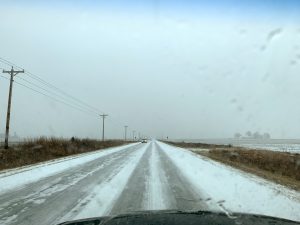InTrans / Feb 11, 2020
The relationships between weather and roadway safety

It is no secret that inclement winter weather significantly impacts traffic safety. In fact, between 2010 and 2014, Iowa saw more than 8,000 winter weather-related crashes, including 190 fatalities and serious injuries and 2,200 minor injuries.
In recent years, the Iowa Department of Transportation (DOT) has collected large amounts of detailed data pertaining to winter weather, traffic safety, and winter maintenance operations. Because of the amount of detail in this data, a thorough examination of the interactions between all three became possible.
The study
The study, funded by the Iowa DOT and recently completed in September 2019, set out to analyze the relationships between road weather conditions and crash occurrences in Iowa while also developing crash frequency and severity models that consider weather-related factors. In particular, the researchers used snowplow automatic vehicle location (AVL) data to examine the effects of winter maintenance operations on roadway safety and mobility.
“Our project explored multiple data sets to better understand these relationships,” said lead researcher Jing Dong, a transportation engineer at InTrans.
The developed models utilized data from various sources covering the winters of 2016 to 2017 and 2017 to 2018 and eight Iowa city centers. The weather data, obtained from automated weather observing system (AWOS) and road weather information system (RWIS) units, were fed into the Iowa Environmental Mesonet system, which provides highly granular data across Iowa. And while crash data was extracted from the Iowa DOT crash database, AVL data from snowplows captured metrics such as date and time, longitude and latitude, travel speed, plow position, and material spreading rate.
The findings
Using this data, the models found that roughly a 50/50 split of winter weather-related crashes occurred during a winter storm (i.e., during precipitation) versus outside of a winter storm. The large proportion of crashes outside of a winter storm may have been attributed to the persistence of adverse pavement conditions after the storm ended and possibly drivers’ false sense of safety.
The study also found that crashes resulting from winter events were found to be less severe than comparable crashes during the same timeframe. Weather-related crashes were found to have a greater proportion of property damage only or PDO crashes and a lower proportion of major injury and possible injury crashes.
While counterintuitive, higher crash counts and frequencies were correlated with a higher number of snowplow passes (i.e., greater snowplow activity). This is because the number of snowplow passes directly correlated to storm duration, in that snowplows travel greater distances and spread more material during longer storms.
“We found that more salt use is associated with less crashes in a city. Also, almost one-third of winter weather crashes occurred before a snowplow pass was recorded, suggesting a higher crash risk in the early hours of the winter storm. Proactive maintenance actions and real-time information might help mitigate such risk,” said Dong.
Many of these crashes were found to have occurred along interstate routes. Because these routes have multiple lanes and are plowed frequently, interstate crashes likely occurred close to a snowplow pass. Crashes on Iowa routes tended to occur when plow passes were temporally further away from the time of the crash. Interestingly, the crash severity model showed that these routes are less safe than interstate routes and that both US and Iowa routes had a higher propensity for severe crashes than interstate routes.
These findings can ultimately help inform decision makers about how maintenance operations impact safety.
“Many agencies in the US have implemented AVL in recent years. Yet, navigating the massive data stream proves to be challenging. This project serves as the first step to explore ways of using the data to support Iowa DOT decision making,” said Dong.
Want to know more? Read the full report here.
